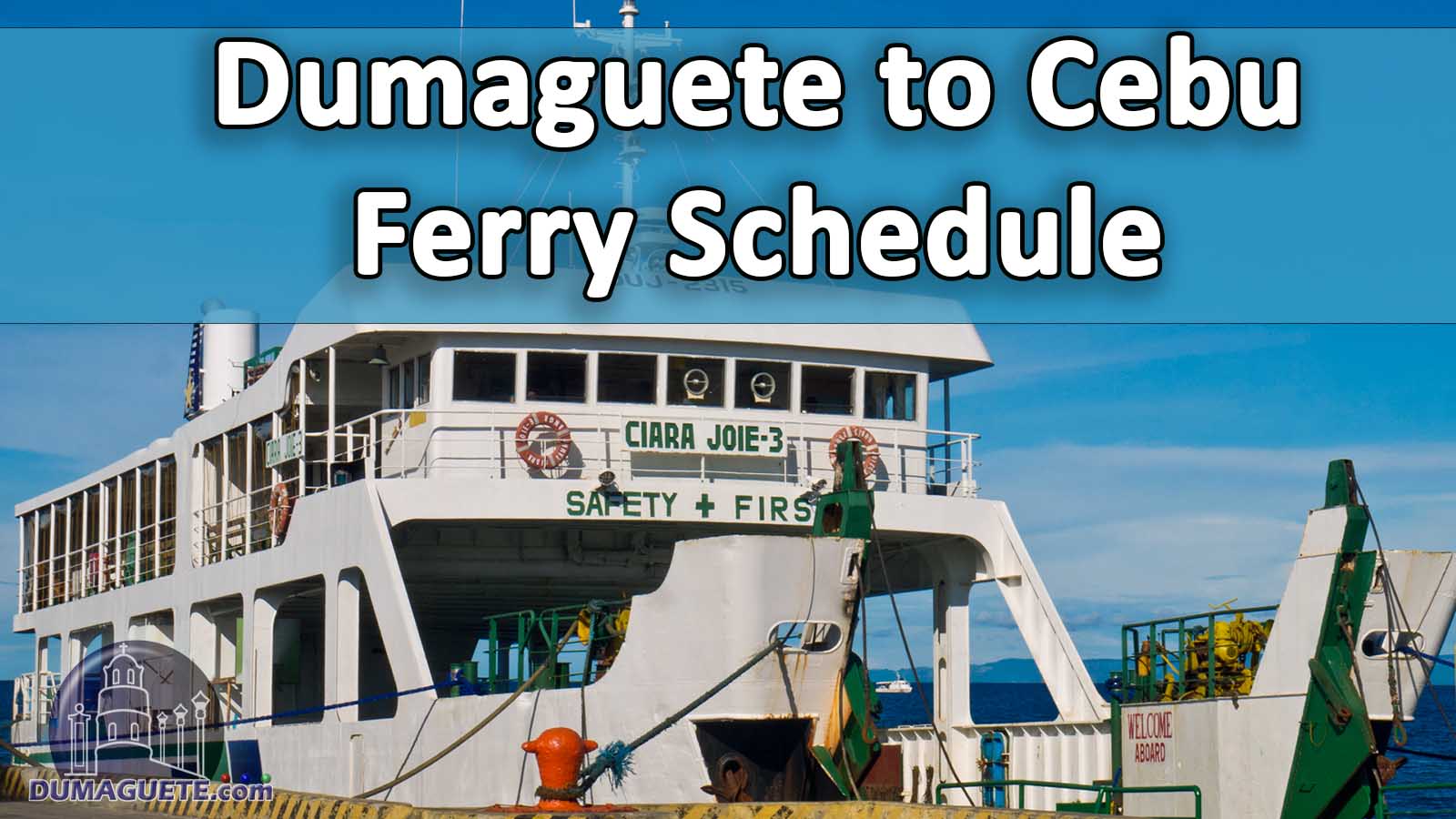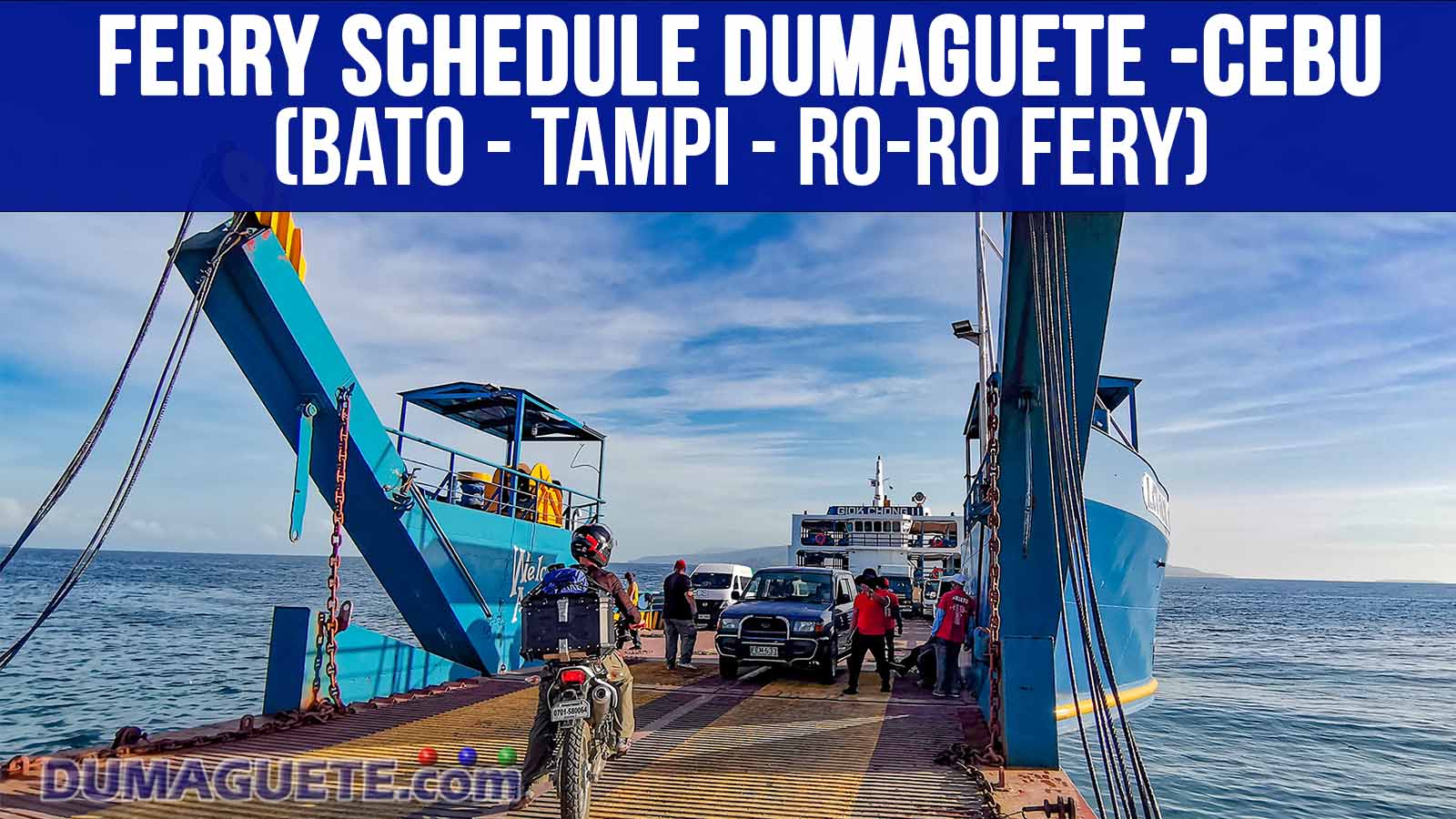Dumaguete to Cebu Ferry Schedule
A ferry from Dumaguete to Cebu is for many travelers the first choice to get to the “Queen City of the South”. It is a cost-effective and generally more affordable than flights, making it an economical choice for budget-conscious travelers. It is a scenic ride with great views of different islands. Most ferries come equipped with comfortable seating, air-conditioning, and amenities like food stalls, making the trip pleasant and relaxing.
There are basically two different options. For once, there are ferries going directly from Dumaguete City to Cebu City. Those trips are taking a few hours but are usually faster than taking a bus. The other way is taking a shorter ferry ride from the neighboring municipality of Sibulan and Amlan to Cebu Island.
These ferries are going to Liloan or Tampi in the southern part of Cebu Island. Many travelers use these options to continue their journey to Moalboal or Oslob for some whale shark watching, for instance.
Latest Ferry Schedules from Dumaguete to Cebu City
Rates and times for Dumaguete to Cebu may change without prior notice.
Please get in touch with the Shipping Lines for the latest updates!
COKALIONG SHIPPING LINES INC.
Dumaguete to Cebu 11:59pm
Tuesday, Friday, Sunday
Departure: 11:59 PM
Arrival: 6:00 AM
Cebu to Dumaguete 8:00pm
Departure: 8:00 PM
Arrival: 2:00 AM
Accommodation Rates: Dumaguete to Cebu Vice Versa
Economy Php 480.00
Tourist Php 680.00
Lounge Php 630.00
Cabin Php 1,310.00/pax
Suite Room Php 2,820 for 2 pax
Php 4,230.00 for 3 pax
Php 5,640.00 for 4 pax
OCEAN JET
Dumaguete to Cebu 7:20am
(Via Siquijor and Tagbilaran)
FARE:
Tourist Aircon Php 1,950.00
Open Air Php1,950.00
Senior Php 1,394.00
Student & PWD Php 1,560.00
Minor Php 975.00
Business Class Php 2,980.00
Business Class Senior Php 2,424.00
Business Class PWD Php 2,590.00
Dumaguete to Cebu 1:00pm
(Via Tagbilaran)
FARE
Tourist Aircon Php 1,700.00
Open Air Php1,700.00
Senior Php 1,215.00
Student & PWD Php 1,360.00
Minor Php 850.00
Business Class Php 2,600.00
Business Class Senior Php 2,115.00
Business Class PWD Php 2,260.00
Cebu to Dumaguete 8:00am
(via Tagbilaran)
FARE
Tourist Aircon Php 1,700.00
Open Air Php1,700.00
Senior Php 1,215.00
Student & PWD Php 1,360.00
Minor Php 850.00
Business Class Php 2,600.00
Business Class Senior Php 2,115.00
Business Class PWD Php 2,260.00
Cebu to Dumaguete 1:00pm
(via Tagbilaran and Siquijor)
FARE
Tourist Aircon Php 1,950.00
Open Air Php1,950.00
Senior Php 1,394.00
Student & PWD Php 1,560.00
Minor Php 975.00
Business Class Php 2,980.00
Business Class Senior Php 2,424.00
Ocean Jet Office is open from 5:00am to 6:40pm
Advance booking cut off 6:00pm
For concern, complaints and inquiries please contact: 0919 066 5964
Latest Ferry Schedules from Dumaguete (Sibulan) to Cebu Island
If you just want the Tanon Straight (the channel between Negros Oriental and Cebu Island) you also have multiple options. These ferries are the best option, if you want to bring your own vehicle, want to visit places in south Cebu or continue your journey on the west coast of the Island to get to Moalboal, another great destination for scuba diving and snorkeling.
There is no ferry schedule from the Dumaguete port to southern Cebu directly. However, Sibulan, the next municipality to the north has a Fastcraft and a Ro-Ro Ferry (Roll On – Roll Off). Both go from Dumaguete to Liloan on Cebu. Depending which one you take and the weather conditions, the trips take between 25 minutes and 45 minutes only.
Maayo Shipping INC
4:30am
6:00am
7:30am
9:00am
10:30am
12:00noon
1:30pm
3:00pm
4:30pm
6:00pm
7:30pm
9:00pm
10:30pm
Fare Rates
Sibulan – Liloan and vice versa
Regular Fare Php 130.00
3 to 9 years old Half Fare Php 65.00
SP Php 110.00
PWD and Senior Citizen Php 90.00
3 to 9 years old Php 65.00
Sibulan Port Cellphone: 0945 – 805 – 8284
Maayo Ferries from Sibulan to Liloan are Ro-Ro ferries.
Please call the Maayo office for vehicle-rates.
Cuadro Alas Navigation Lines INC.
Ferry Schedule Sibulan to Liloan
4:30 am (First Trip)
6:00 am to 8:00 pm each full hour
Ferry Schedule Liloan to Sibulan
3:30 am, 4:30 am
6:00 am to 6:00 pm each full hour
7:30 pm (Last Trip)
Cuadro Alas Navigation Lines INC.
Lilo-an, Santander, Cebu
Tel. No.: 0943 3166355
Fares:
Full: 120 Php
SP: 102.00 Php
Senior Citizen: 95.00
Children 3 – 9 years old: (60.00 Php)
Terminal Fee: 15 Php
Maayo Shipping INC
Schedule Trips fro, Bato to Tampi and vice versa
4:00am
5:00am
6:00am
8:00am
9:00am
10:30am
11:30am
12:30pm
2:00pm
3:30pm
5:00pm
6:30pm
8:00pm
9:30pm
11:30pm
Passenger Fare
Regular Fare Php 130.00
3 to 9 years old Half Fare Php 65.00
SP Php 110.00
PWD and Senior Citizen Php 90.00
3 to 9 years old Php 65.00
Maayo Ferries from Bato to Tampi and vice versa are Ro-Ro ferries.
Please call the Maayo office for vehicle-rates.
Tampi Port Call: 035- 527- 2818
Cellphone: 0942 – 205 – 8997 or 0917 – 710 – 7080
Bato Port Cellphone: 0945 – 805 – 8285
Rates and times for Dumaguete to Cebu and vice versa may change without prior notice.
Please get in touch with the Shipping Lines for the latest updates!
Some Facts about Cebu City
Historical Significance:
Cebu City is often referred to as the “Queen City of the South” and is the oldest city in the Philippines. It was the first Spanish settlement in the country and served as the country’s first capital. The city is where Portuguese explorer Ferdinand Magellan planted a cross in 1521, marking the introduction of Christianity to the Philippines.
Magellan’s Cross:
One of the most famous landmarks in Cebu City is Magellan’s Cross, which is housed in a chapel near the Basilica del Santo Niño. The cross is believed to be the original one planted by Magellan.
Sinulog Festival:
Cebu City is known for the Sinulog Festival, held annually every third Sunday of January. It is one of the largest and most colorful festivals in the Philippines, celebrated in honor of the Santo Niño (Child Jesus). The festival features a grand parade with participants dressed in vibrant costumes, dancing to traditional music.
Economic Hub:
Cebu City is a major economic center in the Visayas region and the second most important urban area in the Philippines after Metro Manila. It has a thriving business process outsourcing (BPO) industry, tourism, and shipping.
Tourism:
The city is a gateway to many of the Philippines’ top tourist destinations, including beautiful beaches, diving spots, and historical sites. The nearby island of Mactan is famous for its resorts and diving sites.
Education:
Cebu City is home to several major universities, including the University of San Carlos, which is one of the oldest schools in the country, tracing its roots back to 1595.
Cebuano Culture and Language:
The people of Cebu City are primarily Cebuanos, and the Cebuano language, also known as Bisaya, is widely spoken in the city. It is one of the most spoken languages in the Philippines.
Cuisine:
Cebu is famous for its local cuisine, especially “lechon” (roast pig), which is often regarded as the best in the country. The city is also known for its dried mangoes, a popular export product.
Infrastructure and Development:
In recent years, Cebu City has seen rapid development with the rise of modern infrastructures such as high-rise buildings, shopping malls, and IT parks, which contribute to its growing reputation as a dynamic and modern city.
Cebu City Port:
The city is a major hub for shipping and logistics in the Philippines, with its port being one of the busiest in the country. It plays a crucial role in trade and commerce, connecting the Visayas and Mindanao regions with the rest of the world.
Some Facts about the Island of Cebu
Cebu Island is one of the most important and popular islands in the Philippines, known for its rich history, diverse culture, and stunning natural beauty. Here are some key facts about Cebu Island:
Geography:
The Island is located in the central part of the Visayas region in the Philippines. It is long and narrow, stretching about 196 kilometers (122 miles) from north to south and about 32 kilometers (20 miles) wide at its widest point. The island is surrounded by 167 smaller islands and islets, including Mactan Island, Bantayan Island, and the Camotes Islands.
Historical Importance:
It is the site where Ferdinand Magellan, the Portuguese explorer, first arrived in the Philippines in 1521. It was in Cebu where he met the local ruler Rajah Humabon and where the first Catholic mass in the country was held. Cebu also witnessed the Battle of Mactan, where Magellan was killed by the local chieftain Lapu-Lapu.
Economic Hub:
Cebu Island is a major economic center in the Philippines, particularly in the Visayas region. It has a strong economy based on tourism, manufacturing, trade, and services. The island is a hub for business process outsourcing (BPO) companies and is known for its export products such as furniture, electronics, and garments.
Tourism:
As one of the top tourist destination in the Philippines, the Island is attracting millions of visitors each year. It is famous for its pristine beaches, crystal-clear waters, and vibrant coral reefs, making it a favorite spot for diving, snorkeling, and other water activities. Popular tourist spots include the white sand beaches of Malapascua Island, the whale sharks in Oslob, and the Kawasan Falls in Badian.
Cultural Heritage:
Cebu Island has a rich cultural heritage, influenced by a mix of indigenous, Spanish, and Chinese traditions. The island is known for its festivals, particularly the Sinulog Festival, which is celebrated in Cebu City but has roots that span the entire island.
Cebuano Language:
The primary language spoken on Cebu Island is Cebuano, also known as Bisaya. It is one of the most widely spoken languages in the Philippines. English and Filipino (Tagalog) are also commonly used, especially in business and education.
Natural Resources:
Cebu Island is rich in natural resources, including limestone, dolomite, and sand and gravel. The island’s fertile land also supports agriculture, with crops such as corn, rice, and mangoes being grown.
Biodiversity:
The island is part of the Coral Triangle, a region known for its incredible marine biodiversity. Cebu’s surrounding waters are home to a variety of marine species, including fish, corals, and other marine life, making it a prime destination for scuba diving and marine conservation efforts.
Infrastructure:
The Island is well-connected with modern infrastructure, including the Mactan-Cebu International Airport, which is the second busiest airport in the Philippines. The island also has a network of roads, bridges, and ports that facilitate trade and travel within the region.
Colonial and Religious Sites:
Cebu Island has numerous historical and religious sites, including the Basilica del Santo Niño, the oldest Roman Catholic church in the country, and Fort San Pedro, a military defense structure built by the Spanish. These sites are key attractions for visitors interested in the island’s colonial history.
Cebu Island’s combination of natural beauty, cultural richness, and economic vitality makes it one of the most dynamic and attractive destinations in the Philippines.





Leave a Reply
Want to join the discussion?Feel free to contribute!